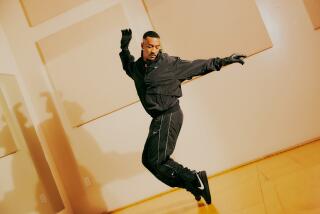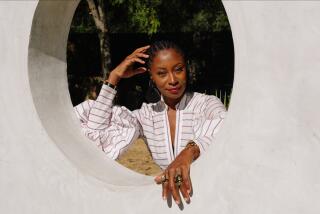Stephen Petronio and Trisha Brown: Moving in the same dance circles
Reporting from New York
Stephen Petronio and Trisha Brown see each other’s New York-based companies perform whenever they can. Friends and like-minded choreographers for more than 25 years, they both make sensual dances, packed with ideas. But when they come to the Los Angeles area soon, they’ll be too busy preparing for their performances to take in each other’s concerts.
Says Petronio in a recent conversation, “I’ll never stop being swept up in Trisha’s work.”
The 11-member Stephen Petronio Company is bringing the choreographer’s hit “Underland,” performed to songs by Australian rocker Nick Cave, to Riverside and Santa Barbara this week. Days later, Brown and her troupe visit the Northridge Valley Performing Arts Center. Within a week, lucky audiences can check out two major artists linked in modern dance history.
“On the surface,” says Petronio, bald, tattooed and 55, “I’m more aggressive and provocative than Trisha. But both of us pour information into every movement. That’s what we thrive on.”
Brown says, “ My choreography is about change. It is sometimes metaphoric, using memory as a resource. For me, this brings reality to the movement and modulates its quality and texture.”
Brown’s and Petronio’s genius for rich and complex dances, accompanied by the courage to keep experimenting, has propelled their careers and earned Brown, 74, a place in dance’s pantheon. (She recently received a New York Dance and Performance Award, or “Bessie,” for lifetime achievement.) Passionate about their work, they don’t want audiences to leave unmoved or without resonant images.
Petronio originally choreographed “Underland” in 2003 for the Sydney Dance Company, using Cave’s plaintive songs of lust, murder and death. “I never tire of this piece,” he says. “ I adore the music and love how my movement language lives with it. That doesn’t always happen in a work for me.”
A frequent collaborator with hip, contemporary composers, fashion designers and visual artists, Petronio calls himself a “formalist.” But for all its wildness, his choreography is well organized and well constructed, qualities he first admired in Brown. “Trisha and I have a real appetite for formal organization of the chaotic body,” he says. “You have to look at her works many times before really seeing what’s going on.”
Their meeting was a match made in dance heaven. When New Jersey-born Petronio first heard about Brown, he was a student at Hampshire College in Amherst, Mass., taking classes with Steve Paxton, the originator of the dance technique known as contact improvisation. Diane Madden, now rehearsal director of Brown’s nine-person company, was a student at Hampshire at the same time. Petronio and Madden became fast friends and traveled to Boston together to take a workshop with Brown.
Within three years, Brown had hired them both, making Petronio her first male dancer. For seven years, he soaked up her artistry, leaving in 1986 to establish his own company. Madden observed their period together. “It’s easy to see why Stephen and Trisha got along,” she says. “They both have mercurial minds and work super fast. Wit and humor are also a big part of them both. Because they are also very different people, they could play off one another’s creativity.”
Even after 30 years of performing and working with Brown, Madden remains in awe of her talents, which include choreographing for her company, for opera and theater, as well as creating masterful drawings, which have been exhibited at such international festivals as Documenta in Kassel, Germany, and the Venice Biennale. “Trisha has this extraordinary ability to craft exquisite phrases of movement,” she says. “You put that together with her movement vocabulary and you have dances that you never get enough of.”
Her company’s program at the Valley Performing Arts Center should give the audience a good idea of what Madden means. The troupe will perform “Watermotor,” “Opal Loop,” “Foray Forêt” and “Les Yeux et l’âme” (The Eyes and the Soul), an exemplary range of works that Brown choreographed between 1978 and 2011. Among other scores, they are accompanied by marching band music and an excerpt from Rameau’s opera “Pygmalion,” while “Watermotor” is danced in silence.
Brown fell in love with movement early on, recalling that as a child in Aberdeen, Wash., she spent as much time as possible playing outside. “Playing is integrated into my dances,” she says. “There is a spirit of playing in the improvisation and rhythmic structure.” As a member of the Judson Dance Theater in New York in the 1960s, she earned a reputation as a groundbreaker with works consisting of only pedestrian movement. Much of what she did was in reaction to what she calls “convention, pretension, romanticism and sentimentality.”
“Today, my methods of organizing movement and the movement itself are more complex,” she says. “My choreography is about change. The language is abstract, but layered with meaning, even in pure movement. Within the movement phrases, there are total, instantaneous shifts from one physical state to the next. It’s tumultuous to perform, but if the momentum is just right, there is an ease.”
For a long time, Brown didn’t use music for any of her pieces; later, ironically, she began choreographing for opera. She also started collaborating with visual artists, particularly Robert Rauschenberg, using his sets for many of her works. Composer John Cage and choreographer Anna Halprin were also early influences, but her longest and richest collaboration was with Rauschenberg. “There aren’t enough words for me to describe the power of our meeting,” she says.
Though Brown and Petronio have traveled very different paths over the last 25 years, they remain linked by their belief in the power of dance. “What I love about making dance is the unknown,” she says. Acknowledging that there’s a lot of grumbling and fear about the future of dance, Petronio still expresses unreserved optimism. “It’s so essentially human,” he says, “that it can never die out.”
More to Read
The biggest entertainment stories
Get our big stories about Hollywood, film, television, music, arts, culture and more right in your inbox as soon as they publish.
You may occasionally receive promotional content from the Los Angeles Times.






